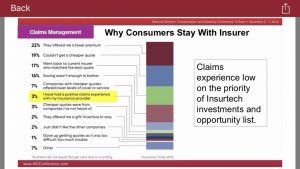Yesterday I recapped my first 5 predictions; today it’s the second 5 (predictions and details are here).
6. Claims counts will bump up
In hurricane-ravaged Puerto Rico, Florida and Texas. Alas a lot of injuries and illnesses will go unreported as unscrupulous companies hire day laborers and don’t insure them, or, in Texas, where work comp isn’t required.
Verdict – as of now, a no. Latest data from FL indicates 2017 saw a decrease in frequency. Texas did too. While that’s not the same as claim count, it implies a reduction.
That said, couldn’t find any data on Puerto Rico (any ideas welcomed) and I’m still suspicious about under-reporting and non-subscriber issues in TX.
7. But frequency will continue to decline, and total claims will too.
because a) frequency almost always declines, and b) we are at or very close to full employment, so a growth in employment won’t counterbalance structural decreases in frequency.
Verdict – yes. Indubitably.
8. Work comp medical costs will increase slightly
On a per-claim basis, expect costs were slightly higher in 2017 than the previous year. Per-claim figures are the best measure, although total medical spend is helpful as well. Kathy Antonello will tell us at NCCI’s Annual Issues Symposium in May…
Verdict – being brutally honest, that’s a wrong. The 4% increase reported by NCCI is a tad higher than “slightly” while it is certainly less than 2016 (6%). HOWEVER – medical costs in California actually decreased Year ver Year (YoY) by about $100 million, or 2.1%. Considering California accounts for roughly 15% of US WC medical spend, that’s a small but meaningful reduction. In the future, I’ll try to be more specific and use quantitative metrics.
9. Innovative new approaches to financing work comp risk will emerge
Variations of peer-to-peer such as Lemonade, some enabled by blockchain technology, will gain a toehold in a few states. Don’t expect there to be a major move just yet as the regulatory, capital requirements, and distribution channels are going to adapt slowly. That said, there’s just too much opportunity to reduce costs inherent in the inefficient administrative processes in today’s workers’ comp system.
Verdict – correct. Pie launched in a handful of states. Oyster started out in California. Lemonade isn’t in workers’ comp – and may never be, but i LOVE their transparency and willingness to speak English to customers. Read this – We Suck – Sometimes...and tell us if you’ve ever seen ANY insurance company be this honest.
Warning – there are some companies out there that talk about disrupting workers comp but don’t seem to have a clue about the underlying business.
10. Payroll fraud incidents and other even more creative efforts to screw workers will increase
I’ll be looking at this in detail, but one quick take is the number of “contingent workers” in many industries has grown dramatically. The biggest increases? farming, fishing forestry; logistics; personal care; protective service, education and training. The implications for comp are deep and broad; lower premiums, claiming incentives, fraud.
Verdict – Correct. Kudos to Matt Capece, the guy who does more to combat this than anyone else I’ve come across. Convictions in Utah, New York, California, Florida, and new legislation in multiple states attest to the impact of Matt and others.
Yet attempts by companies to misclassify workers continue
The net
I was right on 7 out of 10. That’s about what it should be; anything better would mean I was predicting the obvious.
And who wants to be this guy…








